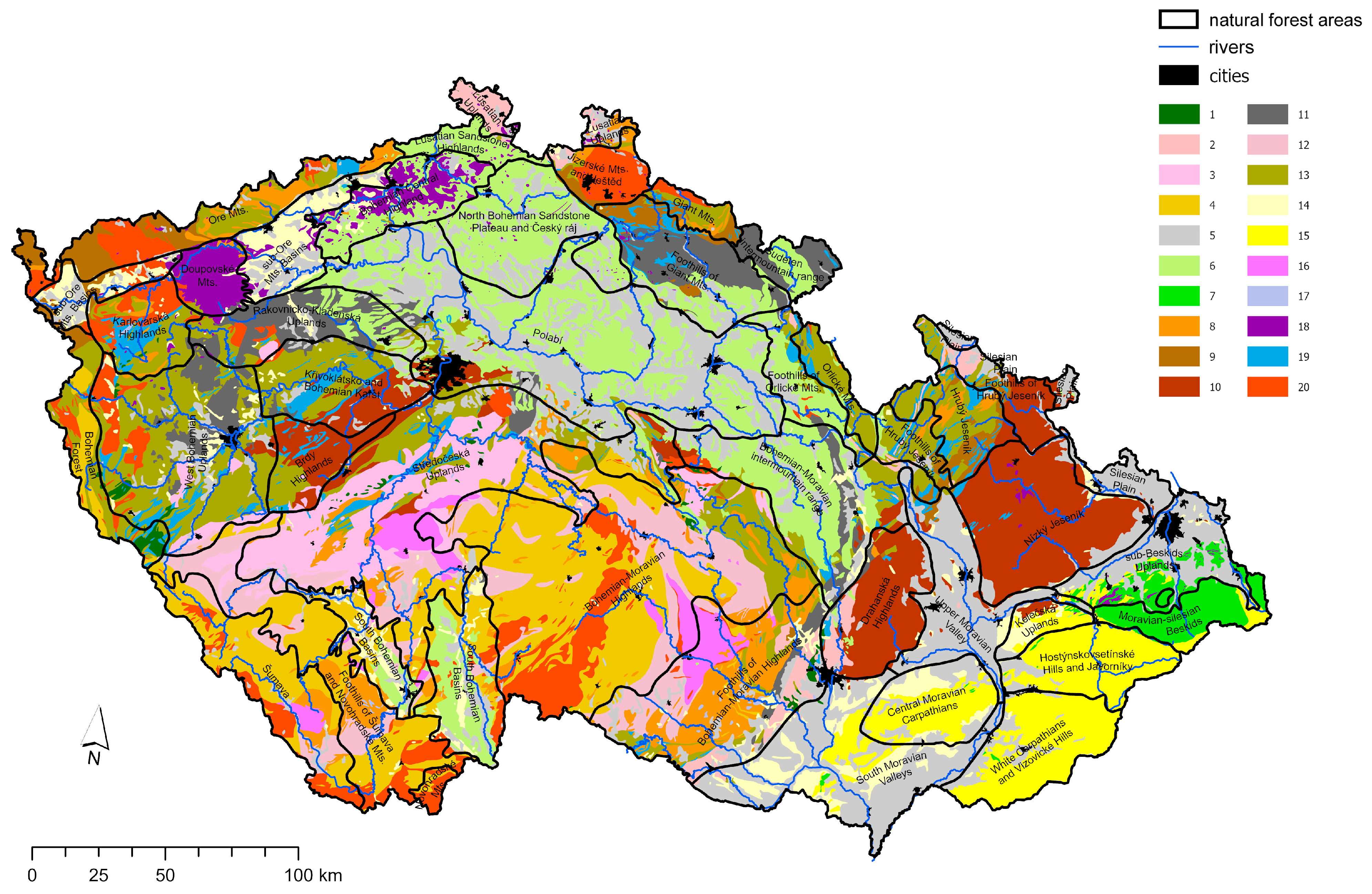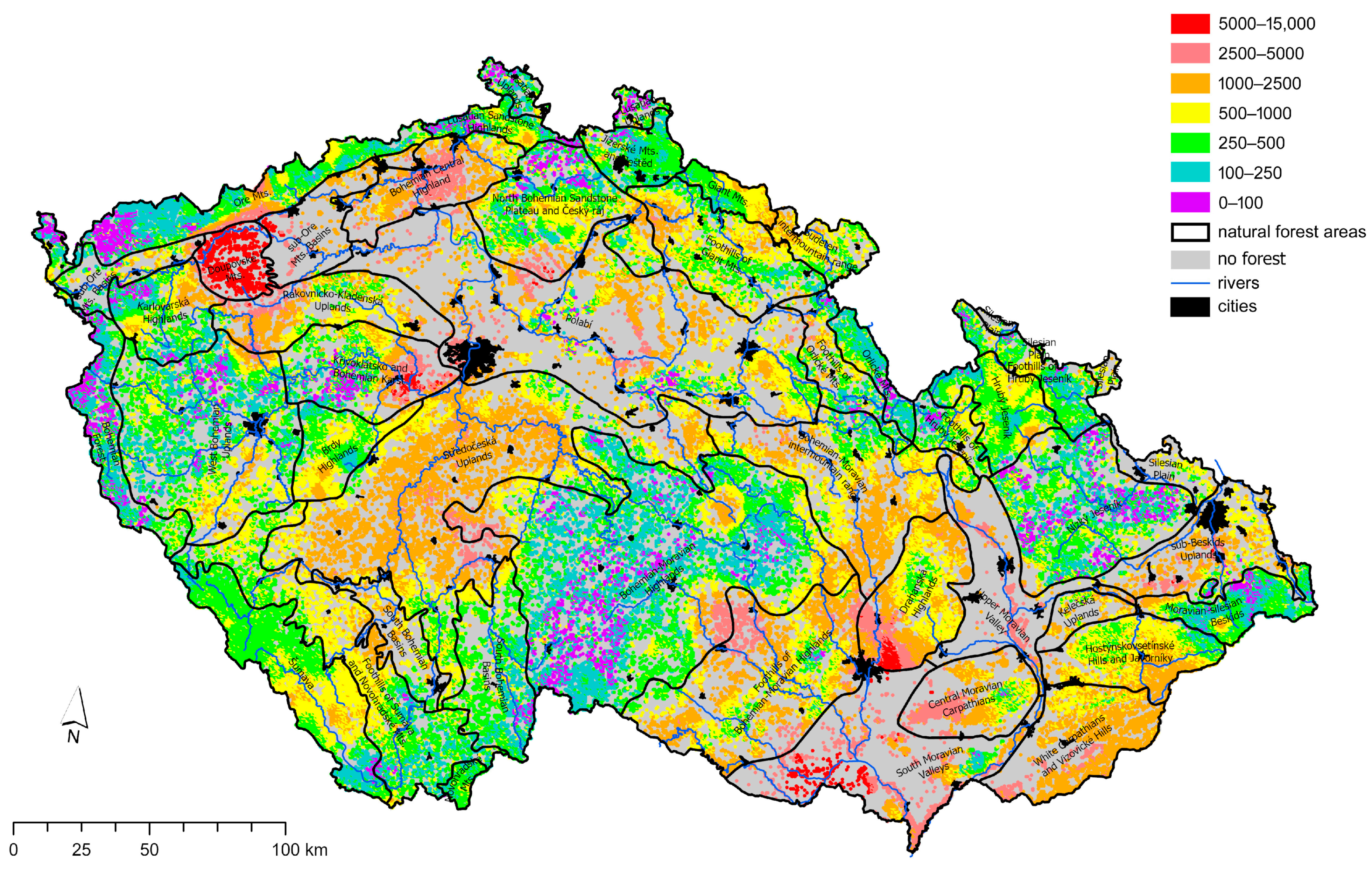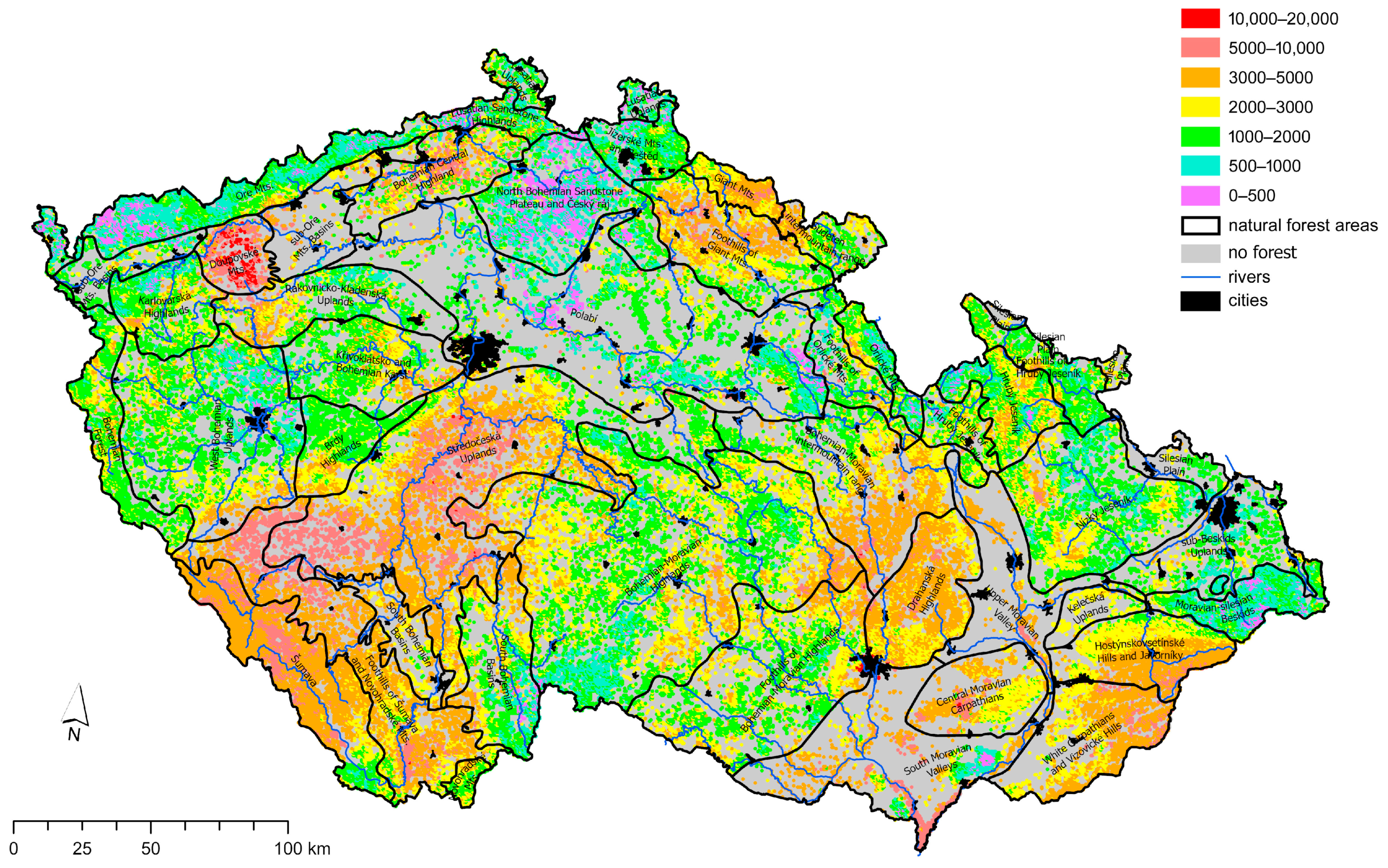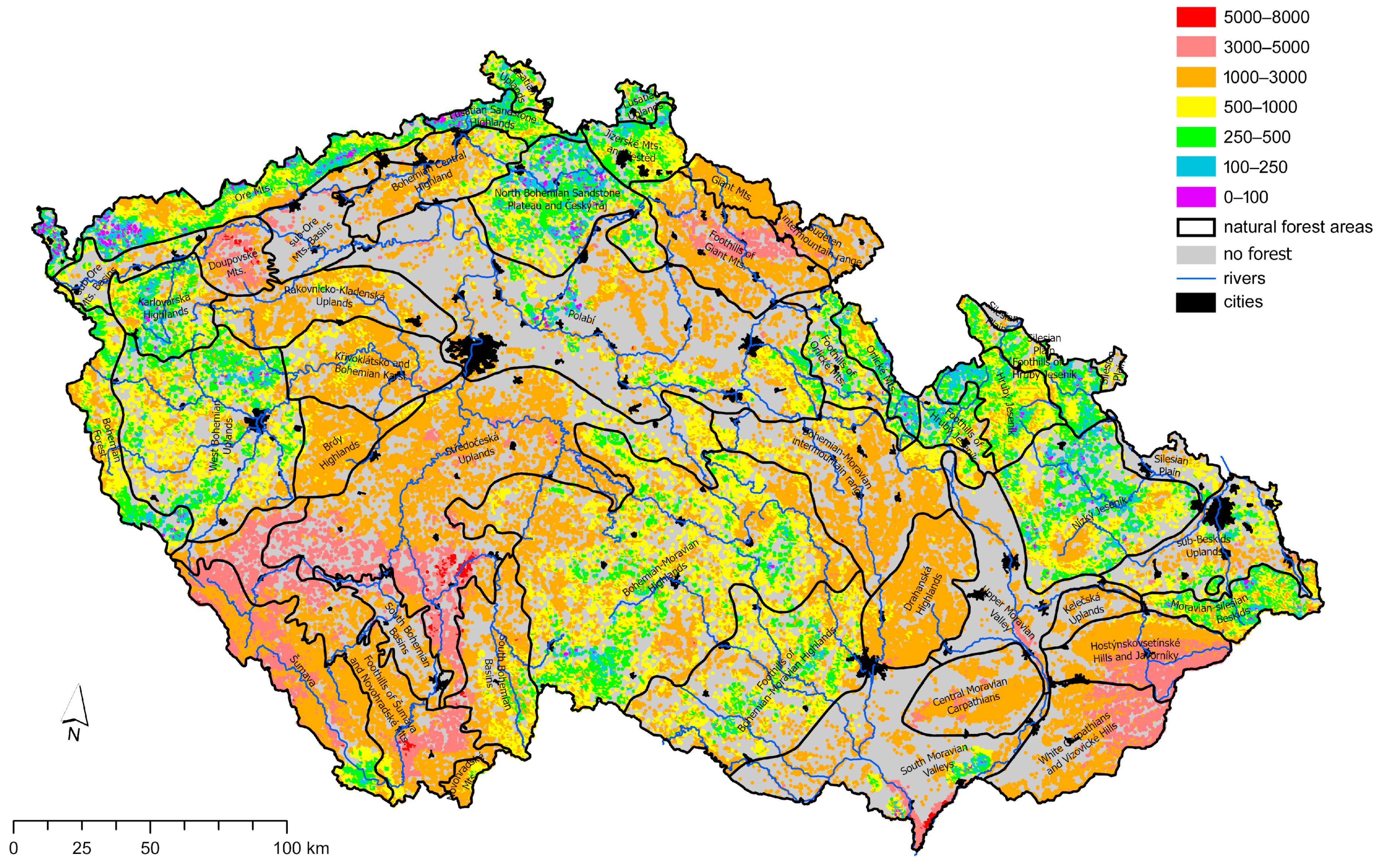Spatial Distribution of Forest Soil Base Elements (Ca, Mg and K): A Regression Kriging Prediction for Czechia
Abstract
1. Introduction
2. Materials and Methods
3. Results
3.1. Descriptive Statistics
3.2. Generalized Additive Models for Location Scale and Shape (GAMLSS) for Base Elements and Their Predictors
3.3. Predicted Maps of Elements
4. Discussion
5. Conclusions
Author Contributions
Funding
Data Availability Statement
Conflicts of Interest
References
- Borůvka, L.; Vašát, R.; Němeček, K.; Novotný, R.; Šrámek, V.; Vacek, O.; Pavlů, L.; Fadrhonsová, V.; Drábek, O. Application of regression-kriging and sequential Gaussian simulation for the delineation of forest areas potentially suitable for liming in the Jizera Mountains region, Czech Republic. Geoderma Reg. 2020, 21, e00286. [Google Scholar] [CrossRef]
- de Vries, W.; Dobbertin, M.H.; Solberg, S.; van Dobben, H.F.; Schaub, M. Impacts of acid deposition, ozone exposure and weather conditions on forest ecosystems in Europe: An overview. Plant Soil 2014, 380, 1–45. [Google Scholar] [CrossRef]
- Rodhe, H.; Dentener, F.; Schulz, M. The global distribution of acidifying wet deposition. Environ. Sci. Technol. 2002, 36, 4382–4388. [Google Scholar] [CrossRef]
- Berger, T.W.; Türtscher, S.; Berger, P.; Lindebner, L. A slight recovery of soils from Acid Rain over the last three decades is not reflected in the macro nutrition of beech (Fagus sylvatica) at 97 forest stands of the Vienna Woods. Environ. Pollut. 2016, 216, 624–635. [Google Scholar] [CrossRef] [PubMed]
- Johnson, J.; Graf Pannatier, E.; Carnicelli, S.; Cecchini, G.; Clarke, N.; Cools, N.; Hansen, K.; Meesenburg, H.; Nieminen, T.M.; Pihl-Karlsson, G.; et al. The response of soil solution chemistry in European forests to decreasing acid deposition. Glob. Chang. Biol. 2018, 24, 3603–3619. [Google Scholar] [CrossRef] [PubMed]
- Yu, Z.; Chen, H.Y.H.; Searle, E.B.; Sardans, J.; Ciais, P.; Peñuelas, J.; Huang, Z. Whole soil acidification and base cation reduction across subtropical China. Geoderma 2020, 361, 114107. [Google Scholar] [CrossRef]
- Cremer, M.; Prietzel, J. Soil acidity and exchangeable base cation stocks under pure and mixed stands of European beech, Douglas fir and Norway spruce. Plant Soil 2017, 415, 393–405. [Google Scholar] [CrossRef]
- Van Der Heijden, G.; Legout, A.; Pollier, B.; Mareschal, L.; Turpault, M.-P.; Ranger, J.; Dambrine, E. Assessing Mg and Ca depletion from broadleaf forest soils and potential causes—A case study in the Morvan Mountains. For. Ecol. Manag. 2013, 293, 65–78. [Google Scholar] [CrossRef]
- Augusto, L.; De Schrijver, A.; Vesterdal, L.; Smolander, A.; Prescott, C.; Ranger, J. Influences of evergreen gymnosperm and deciduous angiosperm tree species on the functioning of temperate and boreal forests. Biol. Rev. 2015, 90, 444–466. [Google Scholar] [CrossRef]
- Nieman, S.C.; Johnson, C.E. Net Geochemical Release of Base Cations from 25 Forested Watersheds in the Catskill Region of New York. Front. For. Glob. Chang. 2021, 4, 667605. [Google Scholar] [CrossRef]
- Novak, M.; Holmden, C.; Andronikov, A.V.; Erban Kochergina, Y.V.; Kirchner, J.W.; Paces, T.; Kachlik, V.; Veselovsky, F.; Hruška, J.; Laufek, F.; et al. Mg, Ca and Sr isotope dynamics in a small forested catchment underlain by paragneiss: The role of geogenic, atmospheric, and biogenic sources of base cations. Geoderma 2024, 442, 116768. [Google Scholar] [CrossRef]
- Novotný, R.; Fadrhonsová, V. Chemismus půd v bukových a smrkových porostech ve dvou přírodních lesních oblastech čr. Zprávy Lesn. Výzkumu/Rep. For. Res. 2021, 66, 277–291. [Google Scholar]
- Podrázský, V.; Moser, W.K.; Novák, J. Changes in the quantity and characteristics of surface humus after thinning treatments. Sci. Agric. Bohem. 2006, 37, 25–28. [Google Scholar]
- Yanai, R.D.; Blum, J.D.; Hamburg, S.P.; Arthur, M.A.; Nezat, C.A.; Siccama, T.G. New insights into calcium depletion in northeastern forests. J. For. 2005, 103, 14–20. [Google Scholar] [CrossRef]
- Chytrý, M. Vegetation of the Czech Republic: Diversity, ecology, history and dynamics. Preslia 2012, 84, 427–504. [Google Scholar]
- Ministry of Agriculture. Information on Forests and Forestry in the Czech Republic by 2017; Ministry of Agriculture of the Czech Republic: Prague, Czech Republic, 2018.
- Rivas-Martínez, S.; Penas, A.; Díaz, T.E. Bioclimatic & Biogeographic Maps of Europe; University of León: León, France, 2004; ISBN 84-9773-276-6. [Google Scholar]
- Tolasz, R.; Míková, T.; Valeriánová, A.; Voženílek, V. Atlas of the Czech Climate; Palacky University in Olomouc—CHMI: Olomouc, Czech Republic, 2007; ISBN 978-80-244-1626-7. [Google Scholar]
- ÚHÚL Forest Area and Forest Cover in the Czech Republic. Available online: https://www.uhul.cz/plocha-lesa-a-lesnatost-v-ceske-republice/ (accessed on 26 May 2024).
- Žáček, J.; Klč, P. Forest transport roads according to natural forest regions in the Czech Republic. J. For. Sci. 2008, 54, 73–83. [Google Scholar] [CrossRef]
- IUSS Working Group WRB World Reference Base for Soil Resources 2014: International Soil Classification System for Naming Soils and Creating Legends for Soil Maps, 3rd ed.; FAO: Rome, Italy, 2014; ISBN 978-92-5-108370-3.
- Němeček, J.; Kozák, J. Status of Soil Surveys, Inventory and Soil Monitoring in the Czech Republic. In European Soil Bureau Research Report No.9, EUR 20559 EN; The European Soil Bureau, Joint Research Centre: Isppra, Italy, 2005; pp. 103–109. [Google Scholar]
- Neudertová Hellebrandová, K.; Fadrhonsová, V.; Šrámek, V. Aggregated database of forest soil chemical properties in the Czech Republic based on surveys from 2000 to 2020. Ann. For. Sci. 2024, 81, 17. [Google Scholar] [CrossRef]
- Sihlahla, M.; Mouri, H.; Nomngongo, P.N. Assessment of bioavailability and mobility of major and trace elements in agricultural soils collected in Port St Johns, Eastern Cape, South Africa using single extraction procedures and pseudo-total digestion. J. Environ. Health Sci. Eng. 2020, 18, 1615–1628. [Google Scholar] [CrossRef]
- FAO. Soil Organic Carbon Mapping Cookbook, 2nd ed.; FAO: Rome, Italy, 2018; ISBN 978-92-5-130440-2. [Google Scholar]
- Hengl, T.; Heuvelink, G.B.M.; Rossiter, D.G. About regression-kriging: From equations to case studies. Comput. Geosci. 2007, 33, 1301–1315. [Google Scholar] [CrossRef]
- McBratney, A.B.; Mendonça Santos, M.L.; Minasny, B. On Digital Soil Mapping. Geoderma 2003, 117, 3–52. [Google Scholar] [CrossRef]
- Tziachris, P.; Aschonitis, V.; Chatzistathis, T.; Papadopoulou, M. Assessment of spatial hybrid methods for predicting soil organic matter using DEM derivatives and soil parameters. Catena 2019, 174, 206–216. [Google Scholar] [CrossRef]
- Vaysse, K.; Lagacherie, P. Using quantile regression forest to estimate uncertainty of digital soil mapping products. Geoderma 2017, 291, 55–64. [Google Scholar] [CrossRef]
- Hengl, T.; Heuvelink, G.B.M.; Stein, A. A generic framework for spatial prediction of soil variables based on regression-kriging. Geoderma 2004, 120, 75–93. [Google Scholar] [CrossRef]
- Stasinopoulos, D.M.; Rigby, R.A. Generalized Additive Models for Location Scale and Shape (GAMLSS) in R. J. Stat. Soft. 2007, 23, 1–46. [Google Scholar] [CrossRef]
- R Core Team R: A Language and Environment for Statistical Computing. 2022. Available online: https://www.R-project.org/ (accessed on 26 May 2024).
- ARCDATA PRAHA, ZÚ, ČSÚ ArcČR 500—Digitální Geografická Databáze 2016. Available online: www.arcdata.cz (accessed on 26 May 2024).
- EEA CORINE Land Cover (CLC) 2018, Version 20, European Environment Agency, Copenhagen, Denmark. Available online: https://www.eea.europa.eu/data-and-maps/data/corine-land-cover-accounting-layers (accessed on 23 October 2020).
- Kozák, J.; Němeček, J.; Jetmar, M. The database of soil information system—PUGIS. Rostl. Vyrob. UZPI 1996, 42, 529–534. [Google Scholar]
- Viewegh, J. Czech Forest (Site) Ecosystem Classification. Česká Zemědělská Univerzita V Praze 2005. Available online: https://www.uhul.cz/wp-content/uploads/Forestry_Classification.pdf (accessed on 26 May 2024).
- Viewegh, J.; Kusbach, A.; Mikeska, M. Czech forest ecosystem classification. J. For. Sci. 2003, 49, 85–93. [Google Scholar] [CrossRef]
- Vašát, R.; Vacek, O.; Borůvka, L. Studying the spatial structure of pedodiversity (Shannon’s entropy) as related to the land area—An example from Czechia. Geoderma Reg. 2023, 32, e00607. [Google Scholar] [CrossRef]
- ArcGIS Pro 3.2.2 2024. ESRI. Available online: https://www.esri.com/en-us/arcgis/products/arcgis-pro/overview (accessed on 26 May 2024).
- Takoutsing, B.; Heuvelink, G.B.M. Comparing the prediction performance, uncertainty quantification and extrapolation potential of regression kriging and random forest while accounting for soil measurement errors. Geoderma 2022, 428, 116192. [Google Scholar] [CrossRef]
- Nawar, S.; Mouazen, A.M. Predictive performance of mobile vis-near infrared spectroscopy for key soil properties at different geographical scales by using spiking and data mining techniques. Catena 2017, 151, 118–129. [Google Scholar] [CrossRef]
- Wan, M.; Hu, W.; Qu, M.; Li, W.; Zhang, C.; Kang, J.; Hong, Y.; Chen, Y.; Huang, B. Rapid estimation of soil cation exchange capacity through sensor data fusion of portable XRF spectrometry and Vis-NIR spectroscopy. Geoderma 2020, 363, 114163. [Google Scholar] [CrossRef]
- de Brogniez, D.; Ballabio, C.; Stevens, A.; Jones, R.J.A.; Montanarella, L.; van Wesemael, B. A map of the topsoil organic carbon content of Europe generated by a generalized additive model. Eur. J. Soil Sci. 2015, 66, 121–134. [Google Scholar] [CrossRef]
- Oppong Sarkodie, V.Y.; Vašát, R.; Pouladi, N.; Šrámek, V.; Sáňka, M.; Fadrhonsová, V.; Hellebrandová, K.N.; Borůvka, L. Predicting soil organic carbon stocks in different layers of forest soils in the Czech Republic. Geoderma Reg. 2023, 34, e00658. [Google Scholar] [CrossRef]
- Djodjic, F.; Bieroza, M.; Bergström, L. Land use, geology and soil properties control nutrient concentrations in headwater streams. Sci. Total Environ. 2021, 772, 145108. [Google Scholar] [CrossRef] [PubMed]
- Rapprich, V. Magmatic and Volcanic Evolution of the Doupovské hory Volcanic Complex. Univerzita Karlova 2009. Available online: https://dspace.cuni.cz/handle/20.500.11956/93758 (accessed on 26 May 2024).
- Militky, J.; Kovacic, V. Ultimate mechanical properties of basalt filaments. Text. Res. J. 1996, 66, 225–229. [Google Scholar] [CrossRef]
- Baron, I.; Cilek, V.; Krejci, O.; Melichar, R.; Hubatka, F. Structure and dynamics of deep-seated slope failures in the Magura Flysch Nappe, outer Western Carpathians (Czech Republic). Nat. Hazards Earth Syst. Sci. 2004, 4, 549–562. [Google Scholar] [CrossRef]
- Terhorst, B.; Damm, B. Slope Stability and Slope Formation in the Flysch Zone of the Vienna Forest (Austria). J. Geol. Res. 2009, 2009, 589037. [Google Scholar] [CrossRef]
- Victoria, R.L.; Martinelli, L.A.; Richey, J.E.; Devol, A.H.; Forsberg, B.R.; Ribeiro, M.N.G. Spatial and temporal variations in soil chemistry on the Amazon floodplain. GeoJournal 1989, 19, 45–52. [Google Scholar] [CrossRef]
- Kadlec, J.; Hercman, H.; Beneš, V.; Šroubek, P.; Diehl, J.F.; Granger, D. Cenozoic history of the Moravian Karst (northern segment): Cave sediments and karst morphology. Acta Mus. Morav. Sci. Geol. 2001, 86, 111–160. [Google Scholar]
- Chuman, T.; Hruška, J.; Oulehle, F.; Gürtlerová, P.; Majer, V. Does stream water chemistry reflect watershedcharacteristics? Environ. Monit Assess 2013, 185, 5683–5701. [Google Scholar] [CrossRef]
- Johnson, C.E. Chemical properties of upland forest soils in the Catskills region: Catskills forest soil chemistry. Ann. N. Y. Acad. Sci. 2013, 1298, 30–42. [Google Scholar] [CrossRef] [PubMed]
- Fernández-Martínez, M.; Vicca, S.; Janssens, I.A.; Sardans, J.; Luyssaert, S.; Campioli, M.; Chapin III, F.S.; Ciais, P.; Malhi, Y.; Obersteiner, M. Nutrient availability as the key regulator of global forest carbon balance. Nat. Clim. Chang. 2014, 4, 471–476. [Google Scholar] [CrossRef]
- Jonard, M.; Fürst, A.; Verstraeten, A.; Thimonier, A.; Timmermann, V.; Potočić, N.; Waldner, P.; Benham, S.; Hansen, K.; Merilä, P.; et al. Tree mineral nutrition is deteriorating in Europe. Glob. Change Biol. 2015, 21, 418–430. [Google Scholar] [CrossRef] [PubMed]
- Gessler, A.; Schaub, M.; McDowell, N.G. The role of nutrients in drought-induced tree mortality and recovery. New Phytol. 2017, 214, 513–520. [Google Scholar] [CrossRef] [PubMed]
- Piao, S.; Sitch, S.; Ciais, P.; Friedlingstein, P.; Peylin, P.; Wang, X.; Ahlström, A.; Anav, A.; Canadell, J.G.; Cong, N.; et al. Evaluation of terrestrial carbon cycle models for their response to climate variability and to CO2 trends. Glob. Change Biol. 2013, 19, 2117–2132. [Google Scholar] [CrossRef]
- Bolte, A.; Block, J.; Eichhorn, J.; Sanders, T.G.M.; Wellbrock, N. Sustainable Use and Development of Forests and Forest Soils: A Resume. In Status and Dynamics of Forests in Germany; Wellbrock, N., Bolte, A., Eds.; Ecological Studies; Springer International Publishing: Cham, Switzerland, 2019; Volume 237, pp. 355–374. ISBN 978-3-030-15732-6. [Google Scholar]
- Aherne, J.; Posch, M.; Forsius, M.; Lehtonen, A.; Härkönen, K. Impacts of forest biomass removal on soil nutrient status under climate change: A catchment-based modelling study for Finland. Biogeochemistry 2012, 107, 471–488. [Google Scholar] [CrossRef]




| Parameter | Ca | Mg | K |
|---|---|---|---|
| Count | 7622 | 7757 | 7753 |
| Mean | 754.5 | 1990.1 | 1044.6 |
| Median | 219.5 | 927.7 | 295.6 |
| SD | 2089.8 | 2665.7 | 1508.9 |
| Minimum | 3.5 | 6.3 | 5.0 |
| Maximum | 41,650.0 | 37,752.6 | 10,981.8 |
| Range | 41,646.5 | 37,746.3 | 10,976.7 |
| 1st quartile | 105.0 | 446.3 | 69.3 |
| 3rd quartile | 533.6 | 2520.8 | 1554.6 |
| Skewness | 8.1 | 3.7 | 2.2 |
| Kurtosis | 91.4 | 23.5 | 6.4 |
| Standard error | 23.9 | 30.3 | 17.1 |
| Ca | Estimate | Std. Error | Pr(>|t|) | Significance |
|---|---|---|---|---|
| (Intercept) | 6.84 | 0.62 | <0.00 | *** |
| Forest type | 0.09 | 0.11 | 0.41 | |
| Edaphic | 0.02 | 0.01 | 0.30 | |
| Altitude | 0.00 | 0.00 | 0.00 | ** |
| Soil type | 0.07 | 0.02 | 0.00 | ** |
| PSP4000m | −0.94 | 0.51 | 0.06 | . |
| PSP7000m | 0.22 | 1.03 | 0.83 | |
| PSP10000m | −0.06 | 1.00 | 0.95 | |
| PSP15200m | 0.17 | 0.56 | 0.77 | |
| AIC | 4675.62 | |||
| Mg | ||||
| (Intercept) | 7.65 | 0.44 | <0.00 | *** |
| Forest type | 0.02 | 0.08 | 0.83 | |
| Edaphic | 0.00 | 0.01 | 0.99 | |
| Altitude | 0.00 | 0.00 | 0.86 | |
| Soil type | 0.03 | 0.02 | 0.07 | . |
| PSP4000m | −0.74 | 0.35 | 0.04 | * |
| PSP7000m | 0.39 | 0.71 | 0.58 | |
| PSP10000m | −0.35 | 0.78 | 0.65 | |
| PSP15200m | 0.36 | 0.44 | 0.42 | |
| AIC | 5352.12 | |||
| K | ||||
| (Intercept) | 7.04 | 0.63 | <0.00 | *** |
| Forest type | −0.02 | 0.12 | 0.85 | |
| Edaphic | 0.00 | 0.02 | 0.97 | |
| Altitude | 0.00 | 0.00 | 0.37 | |
| Soil type | 0.02 | 0.03 | 0.49 | |
| PSP4000m | −0.77 | 0.49 | 0.12 | |
| PSP7000m | 0.36 | 1.03 | 0.72 | |
| PSP10000m | 0.04 | 1.13 | 0.98 | |
| PSP15200m | −0.06 | 0.64 | 0.93 | |
| AIC | 4747.17 |
| Validation Matrix | Ca | Mg | K |
|---|---|---|---|
| Random forest | |||
| R2 | 0.18 | 0.17 | 0.22 |
| Random forest-kriging | |||
| R2 | 0.32 | 0.30 | 0.26 |
| RPIQ | 0.25 | 0.87 | 1.12 |
Disclaimer/Publisher’s Note: The statements, opinions and data contained in all publications are solely those of the individual author(s) and contributor(s) and not of MDPI and/or the editor(s). MDPI and/or the editor(s) disclaim responsibility for any injury to people or property resulting from any ideas, methods, instructions or products referred to in the content. |
© 2024 by the authors. Licensee MDPI, Basel, Switzerland. This article is an open access article distributed under the terms and conditions of the Creative Commons Attribution (CC BY) license (https://creativecommons.org/licenses/by/4.0/).
Share and Cite
Oppong Sarkodie, V.Y.; Vašát, R.; Němeček, K.; Šrámek, V.; Fadrhonsová, V.; Neudertová Hellebrandová, K.; Borůvka, L.; Pavlů, L. Spatial Distribution of Forest Soil Base Elements (Ca, Mg and K): A Regression Kriging Prediction for Czechia. Forests 2024, 15, 1123. https://doi.org/10.3390/f15071123
Oppong Sarkodie VY, Vašát R, Němeček K, Šrámek V, Fadrhonsová V, Neudertová Hellebrandová K, Borůvka L, Pavlů L. Spatial Distribution of Forest Soil Base Elements (Ca, Mg and K): A Regression Kriging Prediction for Czechia. Forests. 2024; 15(7):1123. https://doi.org/10.3390/f15071123
Chicago/Turabian StyleOppong Sarkodie, Vincent Yaw, Radim Vašát, Karel Němeček, Vít Šrámek, Věra Fadrhonsová, Kateřina Neudertová Hellebrandová, Luboš Borůvka, and Lenka Pavlů. 2024. "Spatial Distribution of Forest Soil Base Elements (Ca, Mg and K): A Regression Kriging Prediction for Czechia" Forests 15, no. 7: 1123. https://doi.org/10.3390/f15071123
APA StyleOppong Sarkodie, V. Y., Vašát, R., Němeček, K., Šrámek, V., Fadrhonsová, V., Neudertová Hellebrandová, K., Borůvka, L., & Pavlů, L. (2024). Spatial Distribution of Forest Soil Base Elements (Ca, Mg and K): A Regression Kriging Prediction for Czechia. Forests, 15(7), 1123. https://doi.org/10.3390/f15071123






